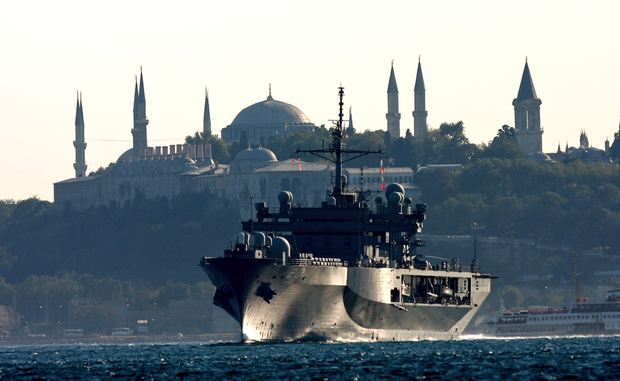 | ||
The Turkish Straits (Turkish: Türk Boğazları) are a series of internationally-significant waterways in northwestern Turkey that connect the Aegean and Mediterranean seas to the Black Sea.
Contents
Map of Turkish Straits, Turkey
They consist of the Dardanelles, the Sea of Marmara, and the Bosphorus, all part of the sovereign sea territory of Turkey and subject to the regime of internal waters. They are conventionally considered the boundary between the continents of Europe and Asia, as well as the dividing line between European Turkey and Asian Turkey.
Owing to their strategic importance in international commerce, politics, and warfare, the Turkish Straits have played a significant role in European and world history, and have since been governed in accordance with the 1936 Montreux Convention.
Geography
As maritime waterways, the Turkish Straits connect various seas along the Eastern Mediterranean, the Balkans, the Near East, and Western Eurasia. Specifically, the Straits allows maritime connections from the Black Sea all the way to the Aegean and Mediterranean Seas, the Atlantic Ocean via Gibraltar, and the Indian Ocean through the Suez Canal, making them crucial international waterways, in particular for the passage of goods coming in from Russia.
The Turkish Straits are made up of the following waterways;
Straits Question
The Straits have been of urgent maritime strategic importance since the Trojan War was fought near the Aegean entrance. In the declining days of the Ottoman Empire the "Straits Question" involved the diplomats of Europe and the Ottoman Empire.
By the terms of the London Straits Convention concluded on July 13, 1841, between the Great Powers of Europe — Russia, the United Kingdom, France, Austria and Prussia — the "ancient rule" of the Ottoman Empire was re-established by closing the Turkish straits to all warships whatsoever, barring those of the sultan's allies during wartime. It thus benefited British naval power at the expense of Russian as the latter lacked direct access for its navy to the Mediterranean.
The treaty is one in a series dealing with access to the Bosphorus, the Sea of Marmara, and the Dardanelles. It evolved from the secret 1833 Treaty of Hünkâr İskelesi (Unkiar Skelessi), in which the Ottoman Empire guaranteed exclusive use of the Straits to "Black Sea Powers" (i.e., Ottoman Empire and Russian Empire) warships in the case of a general war.
The modern treaty controlling relations is the 1936 Montreux Convention Regarding the Regime of the Turkish Straits, which is still in force. It gives the Republic of Turkey control over warships entering the straits but guarantees the free passage of civilian vessels in peacetime.
